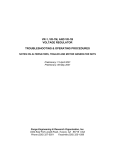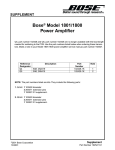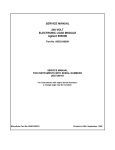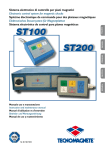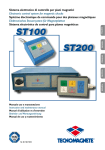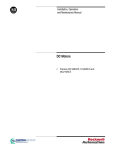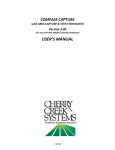Download VR-1 Voltage Regulator, included with each generator
Transcript
VR-1, VR-1M, AND VR-1B VOLTAGE REGULATOR TROUBLESHOOTING & OPERATING PROCEDURES NOTES ON ALTERNATORS, TRAILER AND MOTOR GENERATOR SETS May 2001 Zonge International 3322 East Fort Lowell Road, Tucson, AZ 85716 USA Phone (520) 327-5501 Facsimile (520) 325-1588 Blank Page VR-1x Voltage Regulator Zonge International Page 2 TABLE OF CONTENTS Caution Regarding 32KVA Alternators .......................................................5 Principles of the ZERO alternator system ...................................................6 VR-1M Operation......................................................................................10 Step-by-step Troubleshooting...................................................................11 Alternator Will Not Come Up To Operating Voltage Determine If Problem Is With Alternator Or Voltage Regulator Alternator Will Not Come Up To Operating Voltage With Boost Alternator Exhibits Voltage Runaway Alternator Will Come Up To Voltage But Will Not Hold It Appendix A: Diagrams ..............................................................................20 Appendix B: Maintenance of Motor-Generator Set ...................................33 Daily – Prior to Starting 50-Hour Basic Maintenance 100-Hour Maintenance Addition 200-Hour Maintenance Addition TR-30 Trailer Appendix C: Brushless Generator ............................................................36 Leading Particulars Description and Operation Exciter Armature Exciter Stator Rotating Rectifier Assembly Main Rotating Field Main Generator Stator Appendix D: Transistor and Diode Testing ...............................................42 VR-1x Voltage Regulator Zonge International Page 3 Blank Page VR-1x Voltage Regulator Zonge International Page 4 CAUTION REGARDING 32KVA ALTERNATORS Models ZMG-30, ZMG-25, ZMG-15, SMG-10 The sheave shaft has been carefully aligned with the alternator mount at the factory. The bolts holding the pillow blocks to the frame should never be loosened. The sheave shaft can be removed by removing the alternator and removing the tops of the pillow blocks. If it becomes necessary to reposition the pillow blocks a dial gauge should be attached to the sheave shaft and the pillow blocks should be positioned for not more than +/0.003 inches of concentricity variation between the shaft and the inside surface of the alternator mounting ring. The squaring variation between the pillow blocks mounting surface and the alternator ring surface should not exceed 0.03 inches. VR-1x Voltage Regulator Zonge International Page 5 PRINCIPLES OF THE ZONGE ALTERNATOR SYSTEM Zonge uses 400 cycle alternators to power most of the transmitters used in the field. These alternators produce a balanced 3-phase alternating current (AC). Additionally, certain intrinsic advantages are obtained from a 400-cycle source. The motor and generator efficiency is increased compared to the efficiency of 60 cycle devices. Also, it is lighter in mass and smaller in size than an equivalent 60-cycle system. There are two different types, brush and brushless. Physical laws of electricity and magnetism state that when a magnetic field is rotated within a stationary coil, current is generated in this coil by induction. This is the basic principle behind the design of the alternators used by Zonge. The primary components of these alternators are the stationary coils or output power stator (figure 8) and the rotating field windings located on the rotor (figure 9) which generate the rotating magnetic fields. The sequence of mechanical and electrical steps necessary for the operation may be described in three stages. Start. The gasoline engine turns the rotor (figure 9), and because the rotor maintains a small amount of remnant magnetism (generally from previous use), it creates a rotating magnetic field. This rotating field permeates the rotor and is intercepted by the shunt field windings (figure 7), inducing a current. The shunt windings now act as an electromagnet creating their own magnetic field that excites the armature windings (figure 9), which are coaxial with the shunt field windings. The output voltage from the armature windings is commutated by insulated copper bars (figure 9), resulting in a rectified, or DC output. The DC output from the commutator brushes is fed back through the slip ring brushes (figures 2, 5 and 9) to the rotating field windings. The rotating field windings then are energized, and act as a DC excited electromagnet. When the alternator is running, it is the rotating field windings that create the magnetic field that intercepts the output power stator thereby generating power. In the brushless alternators, there is no commutator. There is a permanent magnet generator that provides power to the rotating field. (See Appendix C) VR-1x Voltage Regulator Zonge International Page 6 Run. The rotating field windings, being energized by the commutated output of the armature windings, act as a permanent magnet. As this magnet is rotated, a rotating magnetic field is created which excites the output power stator. In this way output power is generated. To vary the output power a portion of the shunt field windings output is fed through the voltage regulator (VR) and then to the armature windings. The VR alters the current in the shunt field windings so that the desired AC output is maintained. Boost. The boost sequence will cause current to flow in the shunt field windings, and is necessary only if the rotor has lost its residual magnetism (as a magnetized nail might after a period of time). The frequency of the alternating current induced in the stationary field windings is regulated by the speed of the rotor. This speed, in turn is regulated by the speed of the gasoline engine; i.e., increasing the rpm’s of the engine will increase the frequency of the alternating current. Normally the Zonge system operates at 400 Hz. The voltage output of the alternator is regulated by the amount of direct current (DC) provided to the armature (figure 9) by the shunt field windings. The more direct current that is provided, the higher the voltage output of the alternator. This is the primary function of the voltage regulator. The Zonge voltage regulator (VR) monitors and adjusts the alternator output by establishing both a fixed, and a dependent (adjustable) voltage reference. The 741 opamp (figure 11 (RP1) and figure 13 (RP1)), has its positive input tied to the fixed reference voltage. The dependent reference, the sum of the 3-phase alternator output, is tied to the negative input terminal (T2). The sequence of operations that the VR must perform are as follows: (figure 13) All three phases, phase A (T13), phase B (T14), and phase C (T15), from the alternator, are added together after passing through three separate diodes (RP3). The phase A signal is arbitrarily chosen as the reference phase. This signal passes through the step-down transformer (RP4) to the full-wave rectifier (RP5). VR-1x Voltage Regulator Zonge International Page 7 The output of the full-wave rectifier (RP5) is limited to +/- volts by the Zener diodes (RP6), and is used to power the 741 (RP1) op-amp. The 741 op-amp compares the signal input into terminals 2 (T2) and 3 (T3). The signal at terminal 3 is a voltage reference that is fixed at 6.2 volts by the Zener diode (RP2) (figure 11, upper left corner). The signal at terminal 2 is the average positive peak voltage of the three phase signals. This average voltage is obtained by passing each of the phase outputs of the alternator through a diode and combining the resulting halfwave rectified signals. A filter capacitor acts to average the signal at terminal 2; however, a small 1200 Hz ripple will remain. This is because the output signals (phase A, phase B, and phase C) are displaced 120 degrees from each other. Rectifying gives a positive DC peak voltage and adding these signals results in the 1200 Hz ripple. The most important step in regulating the alternator output takes place if the voltage at terminal 2 exceeds 6.2 volts. When this happens the op-amp turns-on, and produces a -10 volt DC output. Conversely if the voltage at terminal 2 falls below the 6.2 volt fixed reference the op-amp produces a +10 volt DC output. The voltage at terminal 2 may be adjustment establishes the duration time of the op-amp output (I. E., sets the pulse width of he +/- 10 volt signal). The transistors MJ15012 and MJ15011 (figure 12A), comprise what will be referred to as a transistor bank. An MJ15012 and two MJ15011 transistors are located on a separate heat sink (figure 12) directly beneath the main board. The three-phase bridge is mounted here also. The transistor bank is controlled by the op-amp. When the op-amp turns on, it turns on the transistor amplifier causing a conducting path from the DC output of the armature windings (A+) to the shunt field windings (F). The added current in the shunt field windings causes the magnetic field coupled to the armature winding to increase. This in turn causes an increasing output of the armature windings that is fed directly to the rotating field windings. The strength of the rotating field increases which causes the output voltage to go up. VR-1x Voltage Regulator Zonge International Page 8 To cause the output voltage to drop, the op-amp need only be turned off. This opens the path between the armature windings and the shunt field windings. All of the currents and magnetic fields get smaller and the output voltage drops. VR-1x Voltage Regulator Zonge International Page 9 VR-1M OPERATION Attach the cable from the alternator and the cable from the transmitter. Turn the switch to ON. Push briefly the button labeled "BOOST". DO NOT HOLD IT DOWN. This boosts the alternator from the four internal "D" cell batteries. (The alternator can be boosted using an external 12-volt battery by plugging the negative terminal of the battery into the black External Boost banana jack. Briefly touch the positive terminal of the battery to the red External Boost banana jack.) The silver slotted potentiometer controls the voltage, it should be set for 115V. It may need to be set a little higher (117V) to allow for the transmitter loading it. If for some reason the VR-1M fails, an external 24V battery can be used as an unregulated control to temporarily run the BMG-3. To do this, turn the ON/OFF switch to OFF. Plug the battery into the External Boost banana jacks. Red is positive. The voltage is now controlled by the potentiometer with the black knob. NOTE: There are four internal "D" cell batteries. These batteries are used for internal boost. Care must be taken to remove the batteries when the VR-1M will not be used for long periods. The batteries should be changed at least every three months. VR-1x Voltage Regulator Zonge International Page 10 STEP-BY-STEP TROUBLESHOOTING NOTE: If you are unfamiliar with testing procedures, refer to Appendix D. REMEMBER: Very high voltages may be exposed during some of the following tests. USE CAUTION. 1. ALTERNATOR WILL NOT COME UP TO OPERATING VOLTAGE. Boost the alternator with an external 12 volt battery. Connect the battery to the EXTERNAL jacks on the VR (be sure to observe proper polarity) (figure 1). 2. DETERMINE IF PROBLEM IS WITH ALTERNATOR OR VOLTAGE REGULATOR. Attempt to bring the alternator up to voltage as follows: 2.1. Start the engine and bring the RPM up to the required 400 cycles. The frequency will be displayed on the LCD meter, when the toggle switch is set to FREQ (figure 1). 2.2. The ON/OFF switch must be in the OFF position. 2.3. Connect a 12 volt DC source to the EXTERNAL jacks. 2.4. These steps will remove the internal circuitry of the VR from the alternator circuit. 2.5. Adjust the potentiometer (EXTERNAL CONTROL), until 120 volts is displayed on the LCD meter on the VR cover plate. 2.6. Examine the output of the alternator with an oscilloscope. Each of the phases (figure 2, T1, T2, and T3) should be a smooth 120V 400 Hz sine wave. VR-1x Voltage Regulator Zonge International Page 11 3. ALTERNATOR WILL NOT COME UP TO OPERATING VOLTAGE WITH BOOST. 3.1. Preliminary inspection. 3.1.1. Check the fuses, or circuit breakers in the VR. These are accessible on the VR front panel (figure 1). 3.1.2. Check all the connections on the alternator bakelite terminal block. Make sure all the terminal base nuts are tight (figure 2). 3.1.3. Check all the wires and wire ends from the alternator to the VR. 3.1.4. Try to boost again. 3.2. External circuitry check. 3.2.1. Check the continuity of the voltage regulator cable. There are two different types, the CN/6 and the CN/11. Touch one test lead of an ohm-meter to each pin in the military connector on one end of the VR cable. Touch the other ohm-meter lead to each pin on the other end of the VR cable. Each reading should be infinite except for corresponding pins. Now plug the alternator end back into the connector and touch each pin in the military connector while holding the other lead on the neutral bar. There should be less than 3 ohm resistance between each pin and neutral. NOTE: The neutral point of the 3-phase source is connected to terminal posts T4, T5, and T6, which comprise the neutral bar (figures 2 and 10). 3.2.2. (only for old VR-1’s). Set INTERNAL/EXTERNAL switch to EXTERNAL. With the alternator running measure the voltage between the alternator neutral bar and the A+ terminal (positive side of the armature winding) (figure 2). It should be > 12 volts. Failure to detect the full 12 volts indicates that internal circuit tests must be made. Loosen the VR front panel and remove the VR from its case. Initially make a check of the 2 ohm resistor (T6), diode IN5625 (T7), and EXTERNAL CONTROL voltage adjustment potentiometer (T8), refer to the schematic (figures 13 and 11). VR-1x Voltage Regulator Zonge International Page 12 If the tests indicate proper operation, continue to trace the external circuit back to the neutral bar. 3.3. Internal circuitry tests of alternator. BRUSH ONLY - Bendix and Westinghouse 3.3.1. If steps 3.2.1 and 3.2.2 fail to disclose a problem, the next step is to check the alternator itself. Remove the sheet metal protector from around the alternator (figures 2 and 5). This will expose the brushes and commutator. Slip each brush out of its holder (use care, they are carbon, and are delicate). Make sure all connecting wires and brushes are in satisfactory condition. When replacing the brush make sure to put it back in the guide the same way it came out. 3.3.2. If the end of the brush is pitted, try to clean the surface with a knife or fine emery cloth (never use sandpaper). The best technique is to lay the emery cloth on a flat surface and slide the end of the brush back and forth across the emery cloth. If the condition is severe or if the brush is cracked, replace the brush. Do not take a chance on a worn brush scoring the commutator or slip rings. 3.3.3. Check the commutator for burning, pitting, or thrown solder. Clean with crocus cloth. Wrap the cloth around the commutator or slip ring, and pull back and forth on either end in a polishing type of motion. 3.3.4. Check the spring tension on the brushes. The spring tension should be adequate to press the brush uniformly against the commutator. 3.3.5. Check the brush lengths. Minimum brush lengths are: Manufacturer Westinghouse General Electric Bendix 9Kva Slip ring brush 3/4" 1-1/2" 5/8" Commutator brush 3/4" 1" 1/2" NOTE: Brush problems account for a large portion of alternator failures. VR-1x Voltage Regulator Zonge International Page 13 3.3.6. Disconnect all wires from the neutral bar (figure 2). Remove the neutral bar (plate which connects all three posts on upper position of Bakelite terminal block). 3.3.7. Measure the resistance between each of the three neutral terminal posts and the alternator case (find a shiny exposed metal surface). All combinations should have infinite resistance. If this test fails, a short exists somewhere between the 3-phase neutral, and case ground. 3.3.8. Measure the resistance’s between the following pairs of terminal posts. They should measure as indicated: T 1-T 4 T 2-T 5 T 3-T 6 F or F 1-AF or F 1-A+ .2 ohm-.8 ohm .2 ohm-.8 ohm .2 ohm-.8 ohm .2 ohm-.8 ohm .2 ohm-.6 ohm All other combinations should be infinite. VR-1x Voltage Regulator Zonge International Page 14 3.3.9. Failure of the measurements above indicates the following: Less than .2 ohm indicates a short most likely in the armature windings. In most cases, this is a condition that cannot be repaired in the field. Greater than .8 ohm indicates the commutator slip rings need to be cleaned with a crocus cloth. Polish until a shiny fresh surface is exposed. This is only a temporary cure. The rotor will have to be removed and the commutator polished. VR-1x Voltage Regulator Zonge International Page 15 4. ALTERNATOR EXHIBITS VOLTAGE RUNAWAY. Possible causes are: 4.1. The transistor bank (figure 13, RP9) is turned on hard, either by burning out a resistor, or an emitter base junction in a transistor. This forces maximum current to the shunt field. One or several components in the area of the transistor bank (RP9) could be bad. Find and replace the defective part. 4.2. There is unusually high remnant magnetism in the rotor. This usually does not cause voltage runaway. Rather, the normal effect is that the alternator comes up on its own as soon as you switch ON/OFF to ON, before you push the START button. The alternator will require shop service to replace it. 5. ALTERNATOR WILL COME UP TO VOLTAGE BUT WILL NOT HOLD IT 5.1. Perform previous checks, 3.3.1 to 3.3.9. 5.2. Internal Circuit tests on VR. (figures 11a and b) NOTE: On some of the tests it may be necessary to shut down the alternator, turn the VR off and remove the respective component. This is usually the case when examining semi-conductor components. Continuity tests must be made under no-load conditions. 5.2.1. Remove the VR from its case. Examine the wiring for loose, frayed wires. Examine the printed circuit (PC) board for loose parts, burned tracks, signs of arcing, or solder splashes. Take corrective action if needed. 5.2.2. Remove and check the power transistors, refer to Appendix D if unfamiliar with transistor testing. Replace any defective parts. 5.2.3. Examine the two 0.1 ohm resistors between T9 and T10 (figures 11 and 13). Replace if necessary. 5.3. Check the op-amp power supply voltages. Set the multimeter to measure DC volts and a range appropriate for 12 volts. Connect the common lead (black) to the ground (T19) (figures 11 and 13). Connect the positive lead (red) to the +12 volt side of the power supply, (T11). This voltage should be between +11.5 and VR-1x Voltage Regulator Zonge International Page 16 +12>5 volts. Move the positive lead to the -12 volt side of power supply, (T12). This voltage should be between -12.5 and -11.5 volts. 5.3.1. If step 5.3 fails to show the proper power supply voltage, examine the A phase line for proper signal strength. Set the multimeter to measure AC volts and a range suitable for 120 volts. Connect the common lead (black) to ground (T19) and the positive lead (red) to A phase. This voltage should be approximately 120 volts. If the A phase reading measures substantially less than 115 volts the alternator is not functioning properly. Possible problem areas would be the stator windings. 5.3.2. If the A phase reading supply voltage is correct, perform the following checks: 5.3.2.1. Test the signal output from the transformer (figures 11 and 13, T16 and T17). The multimeter should be set for 12 volt AC. The common lead (black) should be connected to ground (T19). The output should be a 24 volt peak to peak sine wave. 5.3.2.2. Test the output of the rectifier bridge (RP5). If the output is not between 11.5 and 12.5 volts, the rectifier may need to be replaced. 5.3.2.3. Test the 1.2 k-ohm resistor for an open circuit or short (figures 11 and 13, T4). Replace if necessary. 5.3.2.4. If the rectifier bridge seems to be operating, test the Zener diodes (T4 and T5). The voltage should be between 11.5 and 12.5 volts. If this is not the case replace the Zener diodes. 5.3.2.5. If all the previous tests confirm that the proper input voltage and appropriate power supply levels are met, proceed to trace the circuit further for other problem areas. 5.4. Check the fixed voltage reference (T3). If the observed measurement is less than 5.6 volts, the Zener diode 1N821 (RP2) must be replaced. 5.5. Next examine the 1200 Hz ripple on the dependent voltage. To do this use an oscilloscope with the dials set to 2 volts/div, and 1 msec/div. VR-1x Voltage Regulator Zonge International Connect the Page 17 ground lead to ground (T19). Examine the dependent voltage (T18). The scope display should be similar to: The amplitude of the ripple should be in the range of 6 to 9 volts. If it is not, then there is too much resistance in the stator windings, or between the alternator output and test the point (T18). Test the components between these points. If any section (or hump) of the ripple signal is missing this indicates that one of the diodes RP3, is defective, or an output phase of the alternator is disconnected. 5.6. Check the 741 op-amp output (T1) with an oscilloscope. Set the scope dials 5 volts/div and 5 msec/div. Connect the ground lead to ground (T19). Put the probe at the output of the op-amp (T1). To keep the signal steady on the screen, the trigger level may have to be adjusted. The output signal should look similar to: If the pulse height is greater than 10 volts, this increased voltage could damage the transistor bank (figure 13, RP9). NOTE: Damage to the transistor bank can cause overvoltage conditions to exist at the transmitter, and/or runaway voltage conditions in the alternator. The pulse width will not necessarily be constant. Turn the voltage adjust potentiometer (on VR front panel) slightly clockwise and counterclockwise, the pulse widths should lengthen, and shorten respectively. VR-1x Voltage Regulator Zonge International Page 18 If no signal output is seen at this point, and all previous steps check out, the opamp is defective. 5.7. Check the 2N5335 transistor (T20) with the oscilloscope. Set the scope dials to 2 volts/div and 1 msec/div. Connect the ground lead to ground (T19). Put the probe on the collector (T20) of transistor 2N5335. The scope should display a series of positive pulses approximately 5.5 volts in magnitude. NOTE: If one transistor is defective, generally all of the connected pairs are similarly affected. For further tests, and procedure instructions for out of circuit continuity tests on semi-conductor devices, refer to the appendix. VR-1x Voltage Regulator Zonge International Page 19 APPENDIX A DIAGRAMS The following diagrams are needed in troubleshooting the current ZMG series MG sets and the VR-1B. Included are wiring diagrams for the ZMG 7.5, ZMG-10, 15, 25 and the ZMG-30 Brushless. 1. VR-1B Voltage Regulator, Front Panel 2. Brush Alternator 3. ZMG-30 Brushless Alternator ALT#2 4. ZMG-30 Motor-Generator Set 5. Brush Alternator 30 KVA 6. Red Bank Alternator, 9 KVA 7. Shunt Field 8. Stator 9. Rotor 10. GE Alternator and VR-1 Voltage Regulator Wiring Diagram 11. Boards 72B and 72C 12. Heat sink, Fig 12A/B: Schematic VR-1B 13. Schematics: A: VR-1, B: VR-1M 14. ZMG-7.5/9 Voltage Regulator Wiring 15. ZMG-7.5/9 Alternator Wiring 16. ZMG-10/15/25 Voltage Regulator Wiring 17. ZMG-10/15/25 Alternator Wiring 18. VR-CN/A Cable: Alternator to Bulkhead 19. VR-CN/11B Cable: Alternator to Bulkhead VR-1x Voltage Regulator Zonge International Page 20 Figure 1 Voltage Regulator VR-1B Figure 2 Brush Alternator VR-1x Voltage Regulator Zonge International Page 21 Figure 3 Brushless Alternator ZMG-30 ALT#2 Figure 4 Motor-Generator Set ZMG-30 VR-1x Voltage Regulator Zonge International Page 22 Figure 5 Brush Alternator 30 KVA VR-1x Voltage Regulator Zonge International Page 23 Figure 6 Red Bank Alternator 9 KVA Figure 7 Shunt Field VR-1x Voltage Regulator Zonge International Page 24 Figure 8 Stator Figure 9 Rotor VR-1x Voltage Regulator Zonge International Page 25 Figure 10. General Electric Alternator and VR-1 Voltage Regulator Wiring Diagram Figure 11 Board 72B VR-1x Voltage Regulator Zonge International Page 26 Figure 11 Board 72C Figure 12 VR-1B Heat Sink VR-1x Voltage Regulator Zonge International Page 27 Figure 12A VR-1B Schematic Figure 12B VR-1B Schematic VR-1x Voltage Regulator Zonge International Page 28 Figure 13 VR-1 Schematic Figure 13 VR-1M Schematic VR-1x Voltage Regulator Zonge International Page 29 Figure 14 Voltage Regulator Wiring ZMG-7.5 Figure 15 Alternator Wiring ZMG-7.5 VR-1x Voltage Regulator Zonge International Page 30 Figure 16 Voltage Regulator Wiring ZMG-10/15/25 Figure 17 Alternator Wiring ZMG-10/15/25 VR-1x Voltage Regulator Zonge International Page 31 MS3118 F 18 - 11 P G H F E D L C K B A J MS3112 E 18 - 11 S VR-CN/A 8 INCHES A K B L C F E D J H G E C B A 14 INCHES A B C D F G H J C B D E F WIRE LENGTH 3 FEET WIRE LENGTH 2 FEET 8 INCHES OVERALL LENGTH OF CABLE: 27 INCHES ALTERNATOR TO BULKHEAD Figure 18 Alternator to Bulkhead Cable VR-CN/A Figure 19 Alternator to Bulkhead Cable VR-CN/11B VR-1x Voltage Regulator Zonge International Page 32 APPENDIX B MAINTENANCE OF MOTOR GENERATOR SET The following is an outline of the general maintenance procedures for Zonge motor/generator sets. It is not a substitute for reading the engine manuals. In addition to the maintenance procedures, a few simple rules should be observed. 1. Allow the engine to idle in order to warm up and cool down when starting or stopping the M/G set. 2. Exhaust fumes are deadly. Do not operate the engine in an enclosed area without sufficient air circulation. 3. Only trained personnel should operate the M/G set. The belts and other moving parts are mechanical hazards. 4. Keep the VR cable, power cable, and battery cables away from moving parts. 5. The batteries can explode. Be careful. Do not short. 6. Belt tension is critical on BMG-3 and ZMG-3 M/G sets. The toothed belts will slip under load. DAILY - PRIOR TO STARTING 1. Check engine for loose or missing nuts and bolts. Check belts for damage. 2. Check oil level, add if needed, do not overfill. 3. Check setscrews in the coupler between alternator and pillow blocks. Grease the coupler. (ZMG-10, -15, -30) 4. Check battery for damage. 5. Clean cooling air intake on motor flywheel. 6. Clean cooling air intake, alternator (blockage, broken wires). 7. Log in daily estimate on engine times. 8. Make sure gas tank is full. 50-HOUR BASIC MAINTENANCE 1. Check air filter, clean filter and filter element if necessary.* 2. Clean crankcase breather cap. 3. Change crankcase oil, replace oil filter. 4. Grease pillow block and pintle/ball hitches on trucks. 5. Lubricate distributor shaft (3 to 5 drops of engine oil at shaft base on Wisconsin engine only). 6. Check belts for wear and tension 400 Hz alternator. VR-1x Voltage Regulator Zonge International Page 33 7. Check belt on 12-volt alternator (Wisconsin engine only). * Note: Small engines should have a foam pre-filter which can be washed by hand and dried before replacing. The Wisconsin filter trap should be cleaned. All filter elements placed into use should be checked for pinholes. Insert a light into the air filter elements and look for "bright" pinholes. 100-HOUR MAINTENANCE ADDITION 1. Clean trailer and engine at self-service ccar wash. 2. Lubricate cam and breaker arm pivot (Wisconsin engine only). 3. Check breaker points for pitting (replace or true with points file). 4. Replace spark plugs. 5. Check in-line gas filter (clean filter screen and glass bowl on Wisconsin).* 6. Check battery connections to solenoid, and solenoid cable connections to starter. 7. Check for loose bolts on starter motor. * Note: Check for dirt, rust, or water in the gas-line filter. 200-HOUR MAINTENANCE ADDITION 1. Check valves. 2. Check timing (Wisconsin engine only). 3. Repair or replace damaged parts on sheet metal cooling shroud. VR-1x Voltage Regulator Zonge International Page 34 TR-30 TRAILER Unladen Weight: 750 pounds Maximum Tongue Weight: 500 pounds Maximum Gross Vehicle Weight: 3,000 pounds Maintenance: The trailer is equipped with bearing and seal protectors on the wheel bearings. These protectors should be filled frequently with wheel bearing grease. Use a water-resistant (boat) grease if the hubs will be submerged in water. Every six months, the wheels should be removed and all surfaces cleaned. When remounting the wheels, tighten the lug nuts with 90-100 foot-pounds. Check the torque after driving for a few yards and then again after 500 miles. Safety: Always cross the safety chains under the tongue and fasten to the automobile frame. Do not fasten to the bumper. The chains should be loose enough to allow slack for cornering. Always attach the 6-pin electric plug to the automobile. Caution: The wheel on the tongue is not meant to support weight while the trailer is in motion. Lift the tongue wheel off of the ground when moving the trailer by hand. If the trailer is crated for transportation, fixed posts should support the tongue, not the tongue wheel. VR-1x Voltage Regulator Zonge International Page 35 APPENDIX C BRUSHLESS GENERATOR TABLE C1. LEADING PARTICULARS Rated Voltage (line to neutral) ..................... 120 v Rated Voltage (line to line) .......................... 208 v Rated Load .................................................. 30kva Power Factor ............................................... 0.75 Frequency ................................................... 400cps Phase .......................................................... 3 Rated Speed ............................................... 5700 rpm Maximum Speed for Regulation .................. 7000 rpm Rotation (Viewing drive end) ....................... Counterclockwise Weight (Max) ............................................... 70lb Bolt Circle Diameter..................................... 10.000in. Drive Spline ................................................. 16-tooth This manual is from Navair 03-5AS-35 VR-1x Voltage Regulator Zonge International Page 36 DESCRIPTION AND OPERATION This generator is a brushless, air-cooled, self-excited, 30-KVA, power supply used to provide alternating electrical power for various aircraft electrical systems. It is rated at 120 volts line-to-neutral and 208 volts line-to-line at the frequency of 380/420 Hertz at the speed of 5700/6300 rpm. A voltage regulator regulates the voltage output level of the generator while a control panel protects the electrical system and components when faults occur within the protective zone by automatically removing the generator from the system. The generator consists of an a-c exciter armature, d-c exciter stator, a rotating rectifier assembly on the rotor shaft, a compensating circuit, main rotating field and the main generator stator. See figure C1 for the location of the main components and figure C2 for a schematic diagram of the generator. The major characteristics of the generator are listed in table C1. The exciter portion of the generator consists of a 6-pole, stationary d-c field and a rotating exciter armature. The operation of the unit is as follows. The exciter stationary field is supplied d-c power from the regulator. This causes a 3-phase, a-c voltage to be developed in the exciter armature. This a-c voltage is rectified by a 3-phase, 1 /2-wave bridge rectifier made up of three silicon rectifiers. The d-c output of the rectifiers is fed into the main rotating field, and this field generates the useful a-c output voltage of the main a-c stator winding. A. Exciter Armature The rotating armature of the exciter consists of wound coil groupings, arranged in 60-degree phase belt windings on a slotted laminated rotor. This provides a 3-phase a-c output to the rotating rectifier. The exciter is designed to have a high synchronous reactance, that is its excitation requirements are more dependent upon its load current than on its voltage. It can be considered to be a current amplifier rather than a voltage amplifier, such as a conventional dc exciter. VR-1x Voltage Regulator Zonge International Page 37 B. Exciter Stator The exciter stator consists of two windings: a shunt field winding connected between terminals F and A-, and a stabilizing winding connected between terminals A- and an unmarked terminal. Figure C1. Main Components of Generator The shunt field winding consists of 6 coils connecting in series; one mounted on each of the 6 poles. Each coil consists of two windings and these windings are connected from coil-to-coil such that the exciter field has two parallel windings. Adjacent poles are of opposite polarity. On one end, both windings are connected to a common terminal (F). On the opposite end, one winding is connected directly to the A- terminal and the other winding is connected, through a thermistor, to the Aterminal. Current supplied by the regulator to the shunt field winding provides excitation for the exciter portion of the generator. In doing so, it controls the exciter output to the main rotating field. VR-1x Voltage Regulator Zonge International Page 38 Figure C2. Schematic Diagram The thermistor, mounted on the exciter frame, has an inverse temperature resistance characteristic. At low or normal temperature, it has a high resistance which effectively blocks current flow in one of the parallel windings and causes the overall shunt field resistance to be approximately that of the remaining single winding. At higher temperature, experienced in normal operation, the resistance of each single winding increases to approximately double. At the same time, the resistance of the thermistor drops to a negligible value permitting approximately equal current to flow in each winding. Thus, combined resistance of the two parallel windings at higher temperatures is approximately equal to that of the single winding at low temperature. Temperature compensation is thereby provided. VR-1x Voltage Regulator Zonge International Page 39 The stabilizing winding is wound directly over the shunt field windings. With the poles as a common magnetic core, a transformer action is thereby provided between the shunt field and the stabilizing winding. Any sudden increase or decrease in the d-c excitation current flowing in the shunt field winding will induce a current flow in the stabilizing winding. This current flow, or signal, fed into the regulator, provides a damping action which opposes any sudden change in regulator output. Thus, voltage fluctuations or transients because of load switching, paralleling operations or faults are held to a minimum. Stability windings are required with magnetic amplifier type regulators, but are not required with transistorized regulations. Three permanent magnets are mounted on the exciter frame in the spaces used for interpoles in a d-c generator. These magnets provide residual magnetism which assures voltage build-up and eliminates the need for field flashing or for a starting relay. The permanent magnet poles are installed in a manner to cause exciter armature reaction, resulting in the initial flow of exciter armature current. This current initiates an output from the main generator stator windings and thus aids the regulator in starting the build-up process. When the generator is up to rated voltage, the exciter armature reaction is in opposition to the permanent magnet and thereby almost completely changes the effect of the permanent magnet. C. Rotating Rectifier Assembly The heart of the brushless generator is the rotating rectifier assembly which makes possible the use of an exciter armature and the elimination of the commutator, slip rings and brushes. The rectifier assembly consists of a 3-phase, 1 /2-wave bridge made up of three silicon rectifiers. These rectifiers provide d-c excitation to the main rotating field. The capacitors assembled to the rectifier assembly suppresses the commutation voltage transients that occur under normal and transient system operating conditions. D. Compensating Circuit VR-1x Voltage Regulator Zonge International Page 40 E. Main Rotating Field The main rotating field consists of eight sets of field coils, connected in series with alternate polarities. The coils are mounted on eight poles which are each an integral portion of the main laminated or stacked core rotor. Each set of coils consists of two coils, a larger and a smaller, which are assembled concentrically on a single pole and connected in like polarity. DC excitation current from the rotating rectifier produces a flux in the eight poles which in turn induces output voltage in the main ac stator windings. Amortisseur, (damper) windings are provided in longitudinal slots in the poles faces and large amortisseur bars serve as wedges between adjacent pole faces holding the field windings in place. Large copper bands under steel bands at each end of the rotor stack provide the electrical, “squirrel cage”, circuit. The amortisseur windings and bars provide an induction motor effect on the generator whenever sudden changes in load or driving torque tend to cause the rotor speed or electrical angle to vary below or above the normal or synchronous system frequency. In isolated generator operation, the windings serve to reduce excessively high voltage transients caused by line-to-line system faults, to dampen torsional vibration originating in the generator drive and to decrease voltage unbalanced loads. In parallel operation, the amortisseur windings will also reduce transients created by manual paralleling, and assist in pulling in, and holding the generator in synchronism. F. Main Generator Stator The main generator stator has windings consisting of lap-wound coil groups arranged in 120-degree phase belts on a slotted laminated stator. These windings are designed for wye connection providing a 3-phase, a-c output voltage of 120 volts line-to-neutral/208 volts line-to-line at a frequency of 400 Hertz with the nominal input speed of 6000 rpm. The leads of the windings are brought directly to the upper surface of the terminal board; thus, aircraft wiring can be clamped directly against the leads without current passing through the terminal studs. VR-1x Voltage Regulator Zonge International Page 41 APPENDIX D TRANSISTOR AND DIODE TESTING USE OF OSCILLOSCOPE D.1. In operating, maintaining, and repairing the electrical field equipment used by Zonge it is frequently necessary to measure voltages and resistances throughout a circuit in order to isolate problem areas. A multimeter and oscilloscope prove useful for troubleshooting purposes. The objective here is to briefly discuss the operation of the multimeter and oscilloscope, and to describe the test procedures used to detect defective components. D.2. To troubleshoot voltages in the circuit the meter should be connected in the following configuration: D.3. To perform continuity tests or check resistance values make sure that the SOURCE IS OFF. Measurements of resistance can be adversely affected by the source and may even be DANGEROUS to the meter and operator. To test for open or short circuits, or resistance values of a particular resistor set the multimeter up as shown below: VR-1x Voltage Regulator Zonge International Page 42 D.4. To test continuity of the diode connect the meter to the diode shown: D.5. In this configuration the meter should measure an approximate short circuit. And, in the second position an open circuit. VR-1x Voltage Regulator Zonge International Page 43 D.6. To test continuity of a transistor connect the multimeter as shown in the following: The corresponding circuit diagrams are: When measuring a PNP transistor reverse the meter test leads; but follow the same diagrams. The measurement should be the same is the transistor is functioning properly. VR-1x Voltage Regulator Zonge International Page 44 D.7. An oscilloscope can be used as an AC, or DC multimeter, an ammeter, a frequency meter, and a phase difference meter. Primarily it is used to display voltage or current waveforms on a cathode ray tube. Several controls are necessary to make the scope the versatile instrument it is. Briefly, the steps that should be followed to operate the oscilloscope successfully are outlined in the following: D.7.1. Getting started ON/OFF power switch INTENSITY controls brightness of trace beam or spot. D.7.2. Input and Channel terminals VOLTS/DIVISION will regulate the height of the displayed waveform. GAIN CONTROL provides continuous gain adjustment between the calibrated positions of the VOLTS/DIV switch. It is best left in calibrated position. AC-DC-GND switch determines whether only AC beam deflection or AC and DC beam deflection (DC setting), or no beam deflection will occur (GND setting). The GND is used to establish a reference line in case of voltage drifts. D.7.3. Positioning HORIZONTAL moves the trace left or right. VERTICAL moves the trace up or down. D.7.4. Time base TIME/DIV switch selects the calibrated trace sweep speed, as it moves across the screen. TRIGGER SOURCE switch selects an AC, DC, or AC+DC signal to start the horizontal oscillator for each sweep. For INTERNAL the sweep triggers on the signal applied to the vertical amplifier. For LINE the sweep triggers on the 60 Hz power line signal. For EXTERNAL the sweep triggers on an externally applied signal. VR-1x Voltage Regulator Zonge International Page 45 TRIGGER LEVEL adjusts the instantaneous voltage level at which the horizontal sweep is triggered. AUTO/NORMAL switch selects between automatic triggering, which disables the above settings, or normal which uses the above switch settings. This is necessary for complex waveforms. Additionally make sure that the test probe can be grounded, with some sort of ground wire. This is not always necessary but in some cases it is essential. VR-1x Voltage Regulator Zonge International Page 46














































